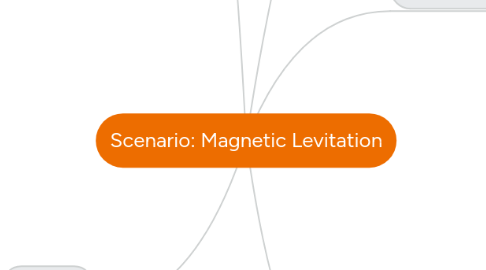
1. F4: Safety
1.1. Constrain users within B-field
1.1.1. Small room chamber
1.1.2. Move B-field with user
1.2. Adjustment of field strength
1.2.1. Gentle
1.3. Uniform B-field
1.3.1. Magnets closely packed
1.3.2. Symmetrical arrangement of magnets
1.4. Emergency supply of permanent magnets
1.5. Cushioning
1.5.1. Inflatable suit
1.5.1.1. Plastic
1.5.1.2. Latex
1.5.1.3. Means of inflation
1.5.1.3.1. Gas-producing chemical reactions
1.5.1.3.2. Air compressor
1.5.2. Inflatable airbag along inner lining of chamber
1.5.3. Cushion on the ground
1.5.4. E-field to generate repulsive force
1.5.5. Bubble wrap
1.6. Physical mechanisms
1.6.1. Safety harness/ rope
1.6.2. Parachute
1.6.3. Huge fan blowing upwards from the bottom
1.6.4. Fastenings on levitation suit cannot be easily undone
1.7. Back-up power supply
1.7.1. Back-up generator
1.7.2. Electromagnetic
1.7.3. System of rechargeable batteries
1.7.3.1. Powered by grid
1.7.3.2. Solar energy
1.7.3.3. Wind energy
1.8. Emergency on-off switch
1.9. Signage/ Instructions to warn against exposure of magnetic devices in levitation chamber
1.9.1. Warning re: effects of B-field on medical devices
1.10. Weight limit (on users)
1.11. Horizontal forces acting on users
1.12. Ensure levitation suit does not crush users with its weight
1.12.1. Light weight suit
1.12.2. Wear suit only in areas of controlled B-field
1.12.3. Crane to aid movements in suit
1.13. Repulsion between suits to prevent forceful collisions
1.14. Prevent motion sickness
1.14.1. Limit demographic groups
1.14.1.1. Age
1.14.1.2. Medical condition
1.14.2. Limit duration of use
1.14.3. Provide medication & medical care
1.14.4. No heavy meals before use
1.15. Safety briefing/ video
1.16. Limit entry to prevent over-crowding
2. F5: Indicate height of levitation
2.1. Sensor
2.1.1. Sonar
2.1.1.1. Doppler effect - convert electric impulse to sound waves
2.1.2. Heat
2.1.3. Infra red
2.1.3.1. Passive
2.1.3.1.1. Detect motion of heat-emitting objects
2.1.3.2. Active
2.1.3.2.1. Beam technology
2.1.4. Hall effect sensor
2.1.5. Laser ride height
2.1.6. Altimeter
2.1.6.1. Pressure
2.2. Modes of height indication
2.2.1. Sound
2.2.2. Glasses
2.2.3. Watch
2.2.4. Grid indicating height on accompanying scale
2.2.4.1. Ruler
2.2.4.2. Measuring tape
2.2.5. Infra red
2.3. Visual approximation
2.3.1. Measure using thumb
2.4. Connect users to the ground using a cord
2.5. Real-time 2D image projection onto wall
2.6. Provide estimation of heights of levitation of different objects/ weights
2.7. Sonic measuring device with laser guide
3. F2: Allow Lateral Movement
3.1. Re: Levitation suit
3.1.1. Compact
3.1.2. Flexible
3.1.3. Thin
3.1.4. Light
3.1.5. Combining materials to maximise ideal properties - like alloying
3.1.5.1. Spandex
3.1.5.2. Nylon
3.2. Assistive mechanisms
3.2.1. Flippers
3.2.2. Guide
3.2.2.1. Strings
3.2.2.2. Bars
3.2.2.3. 3D web
3.2.2.4. Oscillation on rope
3.2.3. Wall
3.2.3.1. Hard
3.2.3.2. Elastic
3.2.3.3. Generates force
3.2.3.3.1. Wind turbines
3.2.3.3.2. Magnetic
3.2.3.3.3. Convection
3.2.4. Manned Maneuvering Unit (jet pack; ejecting compressed air)
3.2.5. Wind currents/ Wind turbines
3.2.6. Shrike vertical take-off & landing aircrafts - vertical propulsion
3.3. Throw objects to gain momentum
3.4. Re: Space
3.4.1. Larger levitation chamber
3.4.1.1. Cylindrical/ Spherical shape; maximise capacity
3.4.2. Cater to small-sized users
3.4.2.1. Target marketing at ideal customer group
4. F3: Control Height of Levitation
4.1. Adjust strength of magnet
4.1.1. Vary current in electromagnet
4.1.1.1. Increase voltage
4.1.1.2. Increase number of turns
4.1.2. Add/ Reduce magnets
4.1.3. Adjust polarity
4.1.3.1. Orientate magnets differenly
4.1.4. Hall sensors to determine & stabilise positions of users
4.2. Adjust mass of external load attached to users
4.3. Limits on weights of users (maximum & minimum)
4.3.1. Weighing station
4.4. Adjust position of magnet
4.4.1. Hydraulic piston
4.4.2. Layers of floating magnets
4.4.3. Gear system
4.4.4. Conveyer belt
4.4.5. Pulley system
4.5. Add-on features
4.5.1. Larger fan to provide greater lift
4.5.2. Suction fan at the top
4.6. Additional force fields
4.6.1. Electric (acting on charged suit)
4.6.1.1. Oppositely-charged plates at various position
4.7. User interface
4.8. Vary surface area of levitation suit
4.9. Adjust relative positions of users to magnetic source
4.10. Change the medium between user and magnetic source
4.10.1. Water
4.11. Areas of adjustment
4.11.1. Ground
4.11.2. Levitation suit
4.11.3. Wall
5. F1: Easily Operable
5.1. Easy to wear
5.1.1. Accessories
5.2. Sensitive to input signals by users
5.3. Visual/ Audio aid
5.4. User interface
5.4.1. Touch screen
5.4.1.1. Resistive
5.4.1.2. Capacitive-surface capacitance
5.4.1.3. Infra red
5.4.1.4. Optical imaging
5.4.1.5. Acoustic pulse recognition
5.4.2. Ergonomic buttons
5.4.3. Number of people operating
5.4.3.1. 0 - Fully automated
5.4.3.1.1. Sensing system for automation network
5.4.3.2. 1 - Remote controlled
5.4.3.3. 2
5.4.4. Controlled mainly by hand, arm and leg movements
5.5. Limit number of features/ actions that users can perform
5.6. Few steps to operate
5.7. Use of holographic emitter/ projection
5.7.1. Using device such as mirrors
5.7.2. Change properties of air (mirage)
